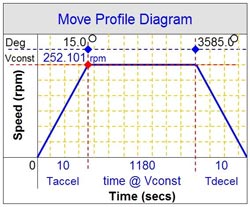
Posted to News on 7th Sep 2013, 16:23
What are IEC 60034-1 electric motor duty cycles?
Motor Technology Ltd offers the following advice relating to duty cycles for electric motors.

The IEC (International Electrotechnical Commission) publishes IEC 60034-1, Rotating electrical machines - Part 1: Rating and performance, which contains classifications for duty cycles to describe a motor's operating conditions. It is vital to know the differences between these duty cycles and to note what mode of operation each rating refers to. Importantly, establishing the duty cycle of a motor and drive for a given application will help to save costs.
In the table below, eight duty cycles are listed, together with their designation and a brief explanation:
tstart{c,80%} [or change the percentage for a different sized table]
tdata{S1|Continuous duty|The motor works at a constant load for enough time to reach temperature equilibrium.}
tdata{S2|Short-time duty|The motor works at a constant load, but not long enough to reach temperature equilibrium. The rest periods are long enough for the motor to reach ambient temperature.}
tdata{S3|Intermittent periodic duty|Sequential, identical run and rest cycles with constant load. Temperature equilibrium is never reached. Starting current has little effect on temperature rise.}
tdata{S4|Intermittent periodic duty with starting|Sequential, identical start, run and rest cycles with constant load. Temperature equilibrium is not reached, but starting current affects temperature rise.}
tdata{S5|Intermittent periodic duty with electric braking|Sequential, identical cycles of starting, running at constant load and running with no load. No rest periods.}
tdata{S6|Continuous operation with intermittent load|Sequential, identical cycles of running with constant load and running with no load. No rest periods.}
tdata{S7|Continuous operation with electric braking|Sequential identical cycles of starting, running at constant load and electric braking. No rest periods.}
tdata{S8|Continuous operation with periodic changes in load and speed|Sequential, identical duty cycles run at constant load and given speed, then run at other constant loads and speeds. No rest periods.}
tend{}
Some motor suppliers quote the peak rating of the motor in product type codes, whereas others use the nominal rating. It is worth checking the technical specification carefully.
Motor Technology recommends talking to a supplier that can give advice on such matters. If you need high start-up torque, but intermittently, some servo drives offer up to three or four times the nominal current for short periods (such as the ServoONE junior and ARS 2000 series), ensuring you get the performance required without paying more than is necessary.
For further advice on duty cycles and the selection of motors and drives, contact Motor Technology.
Want the latest machine building news straight to your inbox? Become a MachineBuilding member for free today >>














